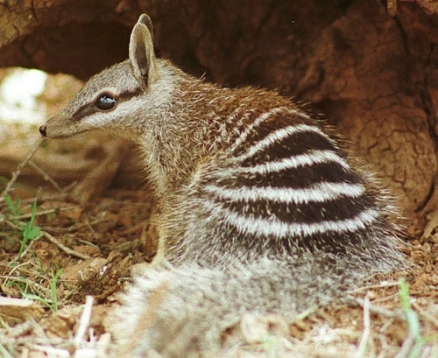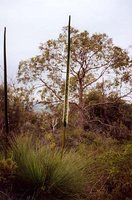Southwest Australia woodlands
Located in the relatively high rainfall region of southwest Western Australia, this region contains forests of jarrah (Eucalyptus marginata) and marri (Eucalyptus calophylla), along with open eucalypt woodlands further inland.
There are several regions of high floristic richness located in this ecoregion, often in upland areas. A number of reduced range and threatened mammals also inhabit this ecoregion.
While there are several large conservation areas in the region, the combined effects of logging, agricultural conversion, and introduced species (Exotic species) have taken a serious toll.
Location and General Description
This ecoregion has limited topographical relief, and is largely occupied by the Yilgarn Block and its margins. This inland plateau ranges from 280 meters (m) to 340 m with subdued dissection. There are several zones with varying degrees of stripping from the Tertiary lateritic profile. The Darling Scarp and Plateau run along the western boundary of the Yilgarn Block. The scarp was uplifted during the Tertiary and reaches elevations of 300 m to 400 m. To the south, this ecoregion is further delineated by the Whicher Range, a crescent-shaped scarp of lateritic Mesozoic sediments. Inland from the Whicher Range, the Blackwood Plateau is 100 m to 150 m above sea level, bounded to the north by the end of the Darling Range, and to the west by the Leeuwin-Naturaliste Ridge. Rainfall varies from 635 millimeters (mm) to 1,300 mm per year, with higher rainfall received near the coast. Rainfall is strongly seasonal with a pronounced summer drought.
Jarrah (Eucalyptus marginata) and marri (Eucalyptus calophylla) forests dominate through much of this ecoregion, with jarrah the dominant species on the Darling Range. Steep, forested valleys surround the Murray River near the Darling Scarp, leading to the more open jarrah and wandoo (Eucalyptus wandoo) woodlands further east on clayey soils. Tall blackbutt (Eucalyptus patens), jarrah, and marri forest can all be found in river valleys.
Further inland, the climate becomes drier and this ecoregion borders on the wheatbelt region of Western Australia. Vegetation here consists of open eucalypt woodlands containing wheatbelt wandoo (Eucalyptus capillosa) and powderbark (Eucalyptus accedens). Wandoo grows on lower slopes and powderbark on higher slopes and plateaus, on gravel. Isolated areas of mallee and rock sheoak (Casuarina huegeliana) also occur. Agonis spp. dominate shrublands on eluvial and alluvial deposits. In regions with Mesozoic sediments, jarrah forests are intermixed with species-rich shrublands.
Biodiversity Features
A model and analysis of flora distributions over southwest Western Australia revealed several areas of high species richness located in this ecoregion. The Whicher Range, possibly the Blackwood Plateau, and to a lesser extent, the Helena Valley east of Perth were all predicted to have high species richness. In general, species richness decreases as one moves inland and areas of high species richness are often prominent upland areas.
Western Australia contains some of the continent's and, indeed, the world's oldest rocks. The southwest region of Western Australia has undergone extensive weathering (Soil erosion and deposition) and leaching, so that low-nutrient soils characterize the region. Erosion] of lateritic landforms led to a mosaic of soil types across the southwest, with greatest local diversity seen along the western side of the wheatbelt region. The high plant diversity is partially in response to variation in the soils, rapidly shifting environmental conditions in the Quaternary, and the region's long isolation from moist eastern Australia.
A number of endangered or restricted range mammals are found in this ecoregion, including the numbat (Myrmecobius fasciatus VU), chuditch (Dasyurus geoffroii VU), woylie (Bettongia penicillata), tammar wallaby (Macropus eugenii), ringtail possum (Pseudocheirus occidentalis VU), southern brown bandicoot (Isoodon obesulus), and red-tailed phascogales (Phascogale calura EN). The kwongan vegetation contains a wide range of nectar-feeding animals, including insects, honeyeaters (Meliphagidae), honey possums (Tarsipes rostratus), and pygmy possums (Cercartetus concinnus). Only one bird is endemic to the region, the western bristlebird (Dasyornis longirostris VU). A subspecies of western corella, Cacatua pastinator pastinator is also found in this ecoregion, with fewer than 2,500 mature birds present.
The herpetofauna of southwestern Australia is characterized by a highly endemic frog fauna: 30 species are known from this region, and all but two are endemic. In this ecoregion, a number of restricted range and endemic frogs occur, including squelching froglet (Crinia subinsignifera) and yellow wart burrowing frog (Heleioporus barycragus).
Current Status
Throughout the southwest of Western Australia, 44 percent of all jarrah forest has been cleared, while nearly 90 percent of all eucalyptus woodlands has been cleared. Logging, agriculture, and mining are all forms of land use in this ecoregion. There are a number of large protected areas in this ecoregion including Dryandra Woodland (approximately 280 square kilometers (km2)), Lane-Poole Reserve (550 km2), and the Perup Forest Ecology Center, 520 km2 of jarrah forest and wandoo woodland. Gioia and Pigott examined conservation areas within a study region that roughly included this ecoregion and the Jarrah-Karri Forests and Shrublands ecoregion to the south and found that 70 percent of all national parks and nature reserves were smaller than 1 km2.
Fifty percent of all mammalian extinctions of the last 200 years occurred in Australia, and a large portion of these extinctions were concentrated in Western Australia. This ecoregion and the well-watered ecoregions along the coast have a better mammalian fauna than the more arid regions, including the wheatbelt, which is marked with a number of extinctions.
Types and Severity of Threats
Threats include introduced weeds (especially grasses, Iridaceae, Asteraceae, Fabaceae, and Brassicaceae), grazing by introduced and domestic animals, and dieback (or root rot) caused by Phytophthora spp. Phytophora cinnamomi is well established in the wetter regions in southwest Western Australia and has caused the collapse of entire ecological communities. Introduced predators are also a serious threat, especially the red fox (Vulpes vulpes).
Alterations associated with agricultural land use are also of concern. Changes in hydroecology through rising water tables and salinization is a threat in the agricultural areas in the inland portion of this region. Agricultural use has also allowed galah (Cacatua roseicapella) to invade from arid regions, but galahs ringbark trees and may be contributing to woodland decline. Some bauxite mining occurs on the western edge of the Yilgarn Plateau which is disturbs native vegetation although mining companies do restore vegetation.
Justification of Ecoregion Delineation
The Southwest Australia Woodlands ecoregion has the same boundary as the 'Jarrah Forest' Interim Biogeographic Region of Australia (IBRA). The Darling Range and the Yilgarn Plateau delineate the outer boundaries of this ecoregion while inland borders are defined largely by the decrease in rainfall. This ecoregion is part of the 'High Rainfall Zone' while the 'Transitional Rainfall Zone' is located inland of this ecoregion.
Additional Information on this Ecoregion
- For a shorter summary of this entry, see the WWF WildWorld profile of this ecoregion.
- To see the species that live in this ecoregion, including images and threat levels, see the WWF Wildfinder description of this ecoregion.
- World Wildlife Fund Homepage
Further Reading
- Burbidge, A.A., and N.L. McKenzie. 1989. Patterns in the modern decline of Western Australia's vertebrate fauna: causes and conservation implications. Biological Conservation 50:143-198.
- Coates, D.J., and K.A. Atkins. 2001. Priority setting and the conservation of Western Australia's diverse and highly endemic flora. Biological Conservation 97: 251-263.
- Garnett, S.T., and G.M. Crowley. 2000. The Action Plan for Australian Birds 2000. Environment Australia, Department of the Environment and Heritage, Canberra, Australia. http://www.ea.gov.au/biodiversity/threatened/action/birds2000/cont.html. viewed on October 3, 2001.
- Gioia, P., and J.P. Pigott. 2000. Biodiversity assessments: a case study in predicting richness from the potential distributions of plant species in the forests of south-western Australia. Journal of Biogeography 27: 1049-1064.
- Hilton-Taylor, C. 2000. The IUCN 2000 Red List of Threatened Species. IUCN, Gland, Switzerland and Cambridge, United Kingdom. ISBN: 2831705657
- Hopper, S. D., M. S. Harvey, J. A. Chappill, A. R. Main, and B. Y. Main. 1996. The western Australian biota as Gondwanan heritage - a review. Pages 1-46 in S. D. Hopper, J. A. Chappill, M. S. Harvey, and A. S. George, editors. Gondwanan Heritage: past, present, and future of the western Australian biota. Surrey Beatty & Sons, Chipping Norton, Australia. ISBN: 0949324663
- Mittermeier, R.A., N. Myers, P.R. Gil, and C. G.Mittermeier. 1999. Hotspots: Earth's Biologically Richest and most endangered terrestrial Ecoregions. Cemex, Conservation International, Toppan, Japan. ISBN: 9686397582
- Short, J. and A. Smith. 1994. Mammal decline and recovery in Australia. Journal of Mammalogy 75(2): 288-297.
- Strahan, R. 1998. The mammals of Australia. Australian Museum/Reed New Holland. Syndey, Australia. ISBN: 1560986735
- Thackway, R. and I. D. Cresswell. editors. 1995. An Interim Biogeographic Regionalisation for Australia: a framework for establishing the national system of reserves, Version 4.0. Australian Nature Conservation Agency, Canberra.
- Wardell-Johnson, G. and P. Horwitz. 1996. Conserving biodiversity and the recognition of heterogeneity in ancient landscapes: a case study from south-western Australia. Forest Ecology and Management 85: 219-238.
| Disclaimer: This article is taken wholly from, or contains information that was originally published by, the World Wildlife Fund. Topic editors and authors for the Encyclopedia of Earth may have edited its content or added new information. The use of information from the World Wildlife Fund should not be construed as support for or endorsement by that organization for any new information added by EoE personnel, or for any editing of the original content. |


